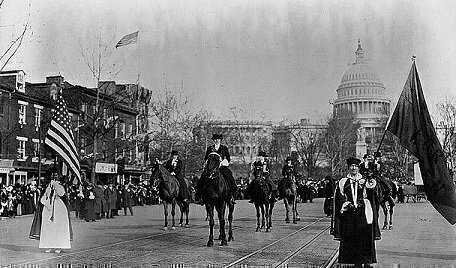“MEN, THEIR RIGHTS, AND NOTHING MORE; WOMEN, THEIR RIGHTS, AND NOTHING LESS.” SUSAN B. ANTHONY, MOTTO, THE REVOLUTION JOURNAL (1868)

The year 2020 marks the 100th anniversary of the passage of the 19th Amendment, guaranteeing and protecting women’s constitutional right to vote. This historic centennial offers an unparalleled opportunity to commemorate a milestone of democracy and to explore its relevance to the issues of equal rights today. The Women’s Vote Centennial Initiative, a collaboration of women-centered institutions, organizations, and scholars from across the US, works to ensure that this anniversary, and the 72-year fight to achieve it, are commemorated and celebrated throughout the United States.

Susan B. Anthony (1820-1906), abolitionist, temperance advocate, and later president of the National American Woman Suffrage Association, who joined with Stanton in 1851 to promote woman suffrage; proposed the constitutional amendment passed many years after her death.
Lucretia Mott (1793-1880), Quaker reformer and preacher, who worked for abolition, peace, and equality for women in jobs and education; organizer of the 1848 Seneca Falls, New York, convention, which launched the women’s rights movement.
THE RIGHT OF CITIZENS OF THE UNITED STATES TO VOTE SHALL NOT BE DENIED OR ABRIDGED BY THE UNITED STATES OR BY ANY STATE ON ACCOUNT OF SEX.
AMENDMENT XIX, AUGUST 26, 1920

FROM THE NATIONAL CONSTITUTION CENTER: Why is August 26 known as Women’s Equality Day?
The 19th Amendment gave women the right to vote nationally on August 18, 1920, so why is Women’s Equality Day on August 26th each year?

The simple answer is that even when a constitutional amendment has been ratified it’s not official until it has been certified by the correct government official. In 1920, that official was U.S. Secretary of State Bainbridge Colby. On August 26, 1920, Colby signed a proclamation behind closed doors at 8 a.m. at his own house in Washington, D.C, ending a struggle for the vote that started a century earlier.
The New York Times ran the story about the document’s signing on its front page and noted the lack of fanfare for the historic event.
Colby had been asked by women’s suffrage leaders Alice Paul and Carrie Chapman Catt to allow groups in Colby’s office for the document’s signing and to film the event. Instead, Colby told reporters that “effectuating suffrage through proclamation of its ratification by the necessary thirty-six States was more important than feeding the movie cameras.”
The Times explained that Colby was concerned about the rivalry between Paul and Catt and wanted to avoid a public scene at the signing.
“Inasmuch as I am not interested in the aftermath of any of the friction or collisions which may have been developed in the long struggle for the ratification of the amendment, I have contented myself with the performance in the simplest manner of the duty devolving upon me under the law,” Colby said.
A package of documents from the state of Tennessee had arrived by train in Washington around 4 a.m. It included the official ratification document from the state legislature.
How Tennessee became the 36th state to ratify the amendment on August 18, 1920, was a story in itself. Congress had passed the proposed amendment a year earlier, and it was supported by President Woodrow Wilson.
By the middle of 1920, 35 states had voted to ratify the amendment, but four other states—Connecticut, Vermont, North Carolina and Florida—refused to consider the resolution for various reasons, while the remaining states had rejected the amendment altogether.
So, Tennessee became the battleground to obtain the three-fourths of states needed to ratify the amendment. Harry T. Burn, a 24-year-old legislator, was set to vote against the amendment, but switched his vote on the Tennessee state house floor at the urging of his mother, assuring the 19th amendment’s ratification.
Yet, even after Burn’s deciding vote, anti-suffrage legislators tried desperately to nullify the previous vote.
In 1971, Representative Bella Abzug championed a bill in the U.S. Congress to designate August 26 as “Women’s Equality Day.” The bill says that “the President is authorized and requested to issue a proclamation annually in commemoration of that day in 1920, on which the women of America were first given the right to vote.”
As a footnote, the amendment certification process has changed since 1920. Now, the Archivist of the United States, who heads the National Archives and Records Administration (NARA), is responsible for finalizing the ratification process.
Back in 1920, Secretary Colby’s attorney reviewed the documents that arrived from Tennessee. Today, NARA’s Office of the Federal Register reviews the documents and writes the proclamation for the Archivist of the United States to sign.
Section 106(b) of the United States Code spells out the finality of the process:
“The Archivist of the United States shall forthwith cause the amendment to be published, with his certificate, specifying the States by which the same may have been adopted, and that the same has become valid, to all intents and purposes, as a part of the Constitution of the United States.”

RIGHTFULLY HERS: AMERICAN WOMEN AND THE VOTE EXHIBIT
The National Archives invites you to browse the wealth of records and information documenting the women’s rights movement in the US, including photographs, documents, audiovisual recordings, educational resources, exhibits, articles, blog posts, lectures and events.

“THE RIGHT [TO VOTE] IS OURS. HAVE IT, WE MUST. USE IT, WE WILL.”
ELIZABETH CADY STANTON, 1848
More Events: Centennial Update



